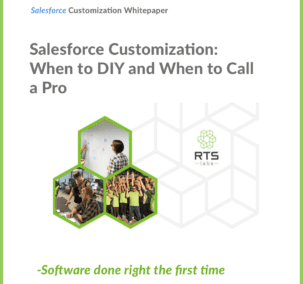Salesforce Implementation Tips: Avoid Common Failures

Are you using Salesforce as your CRM, but do you feel like you were setup to fail almost from day one? Are you frustrated no one is using your system after all the money you’ve spent – and continue to pour into it? Are you wondering if things can get worse? Get ready for part two of Salesforce implementation tips guaranteed to make you fail. Just like in part one of this series, only use these tongue-in-cheek failure tips if you want to fail in your Salesforce implementation. If you’d rather make your Salesforce implementation a success, do the opposite of what’s in this guide.
Blue-Sky Data Plan
There’s no shortage of big picture thinking when it comes to creating a plan for Salesforce, right? One of the most effective ways to guarantee failure is to give little thought to the flow of your data. Instead, embrace blue-sky thinking and hope everything works out for the best in the end. You’ll likely generate few results and a lot of additional frustration by inadvertently creating lots of meetings and documentation to further slow things down …
Alternatively, if you want Salesforce to succeed, then create a data model. This is the secret for creating reporting that makes sense. While you might think of data as a by-product of business activity, there’s far more to it than that. Developing a data model lets you think about reporting in advance. You’ll essentially work backwards from what you think you need, so you know what data needs to be populated into your reports.
Rollout Pandemonium
Another effective Salesforce failure strategy is to make sure users aren’t involved before or during the implementation. By waiting until your system goes live to train them, they’ll have no idea how to use the system. Or, better yet, they’ll skip training altogether. Provided you’ve haven’t involved them in the implementation process, they won’t have bought in to the system. Salespeople will assume it’s another management tactic to get them to perform data entry work …
Reality check. Get everyone on your team using Salesforce by preparing for the build-out phase of the implementation. This includes mapping your ideal processes based on your business requirements and getting everyone’s input on the process. Once a solution engineer has reviewed your requirements, they can go into your system and start customizing Salesforce to meet your needs.
Keep your building process collaborative, too. Stakeholders, your Salesforce Administrator, and your Users will be able to see how their input is used. Check with them continually in case there’s an opportunity for further improvement. Finally, make sure everyone knows what’s going to happen during rollout when you review and approve the documentation.
Salesforce Ownership Apathy
After reading so many ways to fail not just in part two but also in part one of Salesforce Implementation Tips Guaranteed to Make You Fail, you may be wondering if there’s any left? Yet there’s still one more nail to put in the coffin – lack of ownership. In other words, don’t make any effort to get to know the system yourself nor to learn more about the system as you use it. Don’t give your Admin access to the right tools or resources. Then, all the failure measures you’ve put in place will hold …
Or, if you really don’t want Salesforce to fail, make sure your implementation team and users are fully trained before going live. Here’s a checklist of steps you can take.
Salesforce Ownership Success Factors:
- Create an environment of team participation
- Give out incentives for participation
- Make materials accessible
- Re-emphasize the value of Salesforce
- Routinely get User feedback
- Explain how User feedback helped with the launch
- Motivate with recognition
- Continually train Users
A Salesforce Setup to Succeed
OK. Fun’s over. We hope you haven’t taken any of our bad advice to heart. You see, bad Salesforce implementations happen all the time. That’s why it was so easy to put together this list of tips if you want your Salesforce implementation to fail.
But now you also see the steps you can take to make your Salesforce implementation a success! We know you can’t afford to let Salesforce fail. That’s why we’re here to help you turn your troubled implementation into a success story – or better yet, to help you prevent trouble to begin with. (And it may cost less than you think.)
The RTS Labs Salesforce turnaround team is very understanding. Got questions? Reach out just to have a conversation. There’s no obligation and no harm in asking – after all, a few of the right ideas could make all the difference in reducing your frustration and increasing your ROI.
